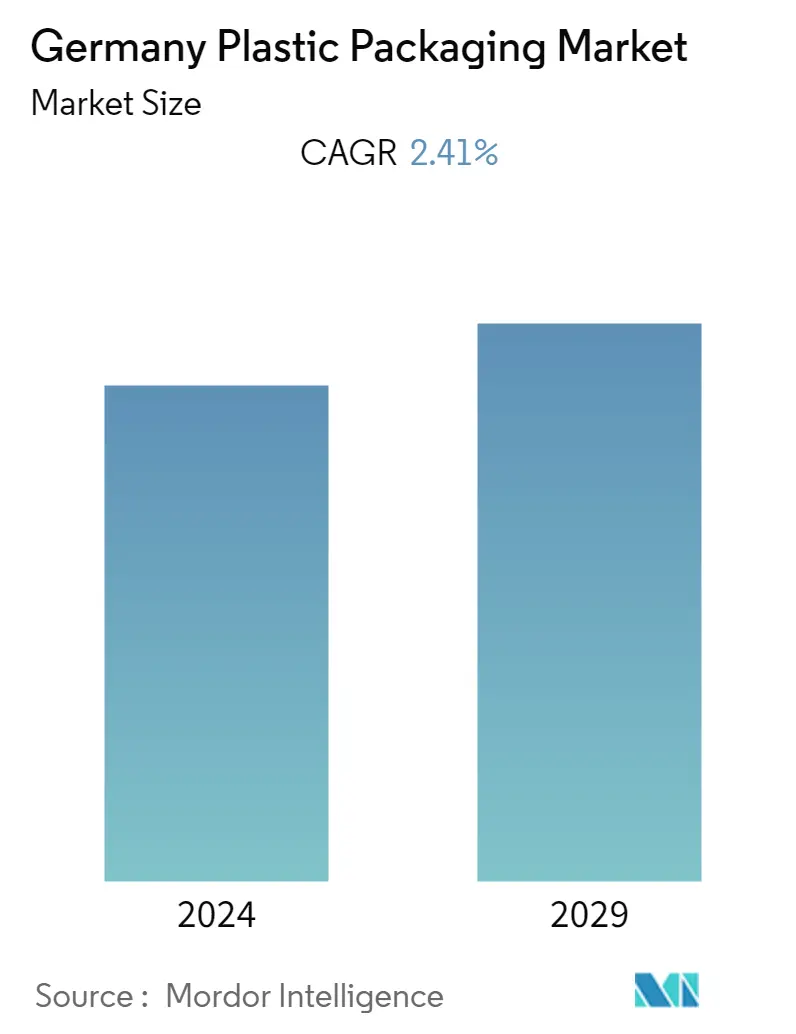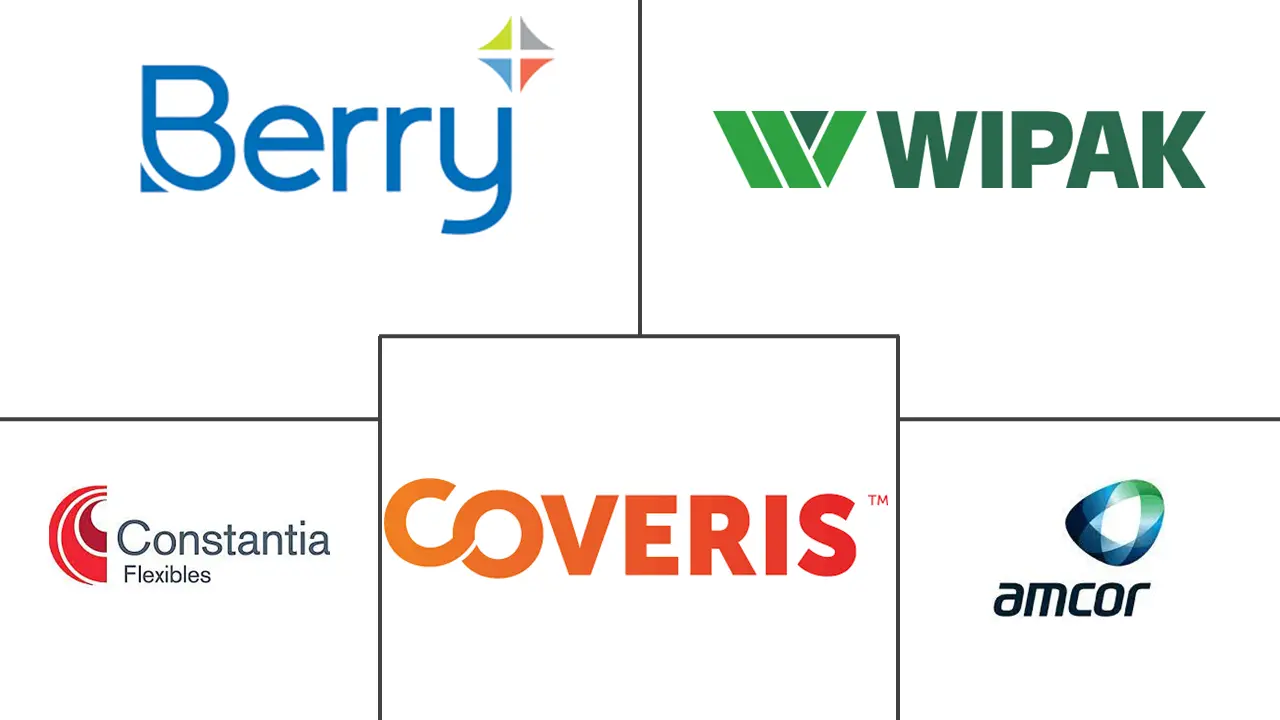Market Size of Germany Plastic Packaging Industry

| Study Period | 2019 - 2029 |
| Base Year For Estimation | 2023 |
| Forecast Data Period | 2024 - 2029 |
| Historical Data Period | 2019 - 2022 |
| CAGR | 2.41 % |
| Market Concentration | Medium |
Major Players
*Disclaimer: Major Players sorted in no particular order |
Germany Plastic Packaging Market Analysis
The Germany Plastic Packaging market is expected to register a CAGR of 2.41% during the forecast period. Plastic packaging became popular among consumers over other products, as plastic is lightweight and unbreakable, making it easier to handle. Even significant manufacturers prefer plastic packaging, owing to the lower production cost. Moreover, introducing polymers, such as polyethylene terephthalate (PET) and high-density polyethylene (HDPE), is expanding plastic bottle applications. The market is witnessing an increasing PET bottles demand.
- Germany is increasingly adopting plastic packaging solutions, owing to the several developments in the country by the solution providers and different end users. The typical consumer perception of 'Made in Germany' goods provided a better performance space for the plastic packaging companies in the region. The government of Germany introduced several stringent regulations for the plastics packaging industry in Germany. The German Packaging Law requires packaging design for recycling, recyclability, and using recyclable and renewable materials. The government aims to recycle 63% of plastic packaging by the last year, up from 40% in 2018. Such measures are expected to profoundly impact the studied market in the envisaged timeline.
- Plastic containers are becoming essential in various end-user industries. New filling technologies and the emergence of heat-resistant packaging material opened up new possibilities and options in the market. While PET bottles are standard in multiple segments, beverages, cosmetics, sanitary products, and detergents are predominantly sold in polyethylene (PE) bottles.
- Furthermore, various German researchers held a meeting at the Czech Republic conference for such an issue discussion. Moisture permeation is one of the common challenges that can impact product quality. A more accurate and reproducible method to determine how effective the packaging is at keeping moisture out would benefit the industry. Accordingly, USP recently revised the packaging and moisture permeation chapters (USP General Chapter Containers-Performance Testing) to include a new method for determining moisture permeation for high and low-barrier pharmaceutical packaging. USP is also considering changing the USP classification system for the packaging, which is limited so far to 'well-closed,' 'tight,' and 'hermetic' containers.
- Since the past decade, awareness among the population regarding the harmful effects of plastic usage is growing drastically. Many public campaigns and initiatives by governments have resulted in increased awareness among the public. Thus, the consumption of plastic packaging witnessed a significant impact in the past few years.
- The growth of the frozen packaged industry across Germany is expected to impact the market positively. For instance, according to Frozen Food Europe, Germany, France, and the United Kingdom account for more than 50% of the frozen food market in Europe. The government-mandated lockdown due to the COVID-19 pandemic aided frozen food sales in many regions and thus impacted the market positively. After the pandemic, the market grew with increased food delivery services.
Germany Plastic Packaging Industry Segmentation
Plastic packaging is a part of the multi-faceted system for providing products, from the point of manufacture to the consumption end. Its principal purpose is to guard and ensure safe and secure product delivery in flawless and perfect condition to the end-user (manufacturer of product or consumer). Its role in a circular economy is to sustain the value of a product as long as required and to help remove product waste.
The Germany Plastic Packaging Market is segmented by packaging type (rigid plastic, flexible plastic), end-user industry (food, beverage, healthcare, personal care, and household, and other end-user), and products (bottles and jars, cans, pouches, trays and containers, films and wraps, and other product types).
The market sizes and forecasts are in terms of value (USD million) for all the above segments.
Germany Plastic Packaging Market Size Summary
The Germany plastic packaging market is experiencing a steady growth trajectory, driven by the increasing adoption of plastic packaging solutions across various industries. The lightweight and unbreakable nature of plastic makes it a preferred choice for both consumers and manufacturers, who benefit from lower production costs. The introduction of advanced polymers like PET and HDPE is expanding the applications of plastic bottles, particularly in sectors such as beverages, cosmetics, and detergents. Despite the growing demand, the market is also navigating challenges related to environmental concerns and regulatory pressures. The German Packaging Law mandates recycling-friendly designs and the use of recyclable materials, aiming to significantly increase the recycling rates of plastic packaging. This regulatory landscape is pushing companies to innovate and adopt circular economy practices, such as increasing the use of recycled materials in their products.
The market is moderately fragmented, with key players like Amcor, Coveris Holding, and Berry Global actively engaging in strategies such as partnerships and acquisitions to enhance their market position. The demand for flexible plastic packaging is on the rise, particularly in the beverage sector, driven by the need for lightweight and cost-effective solutions. The COVID-19 pandemic has further accelerated the growth of the frozen packaged food industry, positively impacting the plastic packaging market. Additionally, initiatives like the EU's Single-Use Plastics Directive and Germany's own recycling targets are encouraging the development of sustainable packaging solutions. Companies are also focusing on improving packaging performance, such as moisture barrier properties, to maintain product quality. As the market evolves, the emphasis on sustainability and innovation continues to shape the future of plastic packaging in Germany.
Germany Plastic Packaging Market Size - Table of Contents
-
1. MARKET INSIGHTS
-
1.1 Market Overview
-
1.2 Industry Value Chain Analysis
-
1.3 Industry Attractiveness - Porter's Five Forces Analysis
-
1.3.1 Bargaining Power of Suppliers
-
1.3.2 Bargaining Power of Consumers
-
1.3.3 Threat of New Entrants
-
1.3.4 Threat of Substitute Products
-
1.3.5 Intensity of Competitive Rivalry
-
-
1.4 Assessment of the Impact of COVID-19 on the Market
-
Germany Plastic Packaging Market Size FAQs
What is the current Germany Plastic Packaging Market size?
The Germany Plastic Packaging Market is projected to register a CAGR of 2.41% during the forecast period (2024-2029)
Who are the key players in Germany Plastic Packaging Market?
Amcor Plc, Coveris Holding, Berry Global, Constantia Flexibles and Wipak UK Ltd. are the major companies operating in the Germany Plastic Packaging Market.

